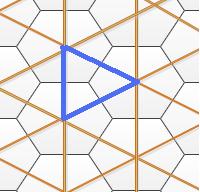Back in college (and before) I played lots of hex grid war gaming against various opponents. Against one opponent in particular the armies would "advance" in a very wide formation with lots of space between units. I finally couldn't understand why he advanced his units in that way (and only in certain game), so I finally asked him what the heck was going on.
The answer was one I never suspected, "Because we have nukes." I stared at him dumbfounded until he explained, in great detail, how the nuclear/chemical rules greatly affected his thinking. We debated (argued more likely) passionately about the benefits/cost of the units until we agreed on few neutral points:
- It provided a minimal benefit in a static situation
- If maneuvering is not performed, it is easily overcome.
- It usefulness in any game which does not include Nuclear/chemical weapons is questionable
- It does count as a 'defense' in the strictest sense of the word.
- It became known as the 'Nuclear Defense', although I tend to call it the 'Nuclear Advance'.
For completeness of the discussion on Hex defense, this article will discuss the benefits and drawbacks of the 'Nuclear Defense'.
Nuclear Defense
The idea of the Nuclear Defense is to prevent large numbers of units from being wiped out by nuclear or chemical weapons. Other than a single unit by itself, this is probably the worst for of defense along the grain possible. A Nuclear Defense consists of units separated by two hexes of distance, as shown below:
 |
| Nuclear Defense/Worst Line Defense |
This defense permits each unit to be surrounded and attacked on five sides at a time. If the distance were any greater, the attacking units could move to completely surround each unit and attack on all six sides. It is from this slight reduction in number of attacking units that we determined it was a form of 'defense'. This configuration does provide some defense, albeit not much better than none at all.
Nuclear Defense Uses
In war games occurring in the modern era, there is one advantage to the Nuclear Defense. Usually the game permits the release of 'tactical nukes' or 'chemical weapons'. These nuclear/chemical weapons have an incredible impact on groupings of enemy units, usually wiping out or severely damaging all areas in the central hex and adjacent hexes. In situations where nuclear/chemical weapons are potentials, it is advisable to not group units. In this case, the 'Nuclear Defense' usually prevents the destruction of more than a single unit with nuclear/chemical weapons.
The question becomes, are nuclear/chemical weapons that much of a threat. Testing this invovled my friend and I setting up several conditions for releasing nuclear weapons and seeing what effect it had on the battlefield. Normally, we employed the following rules:
- We ignored terrain effects for movement prior to nuclear launch.
- We permitted firing of nuclear/chemical weapons without penalty.
- Friendly units could not be within 2 hexes of an affected hex.
Under these conditions, the Nuclear Defense worked reasonably well at preventing a tactical nuclear warhead from devastating an army. I would typically lose 2 or 3 units in Nuclear exchanges, while my opponent would lose only a single unit.
The problem became one of maneuver, when a breach occurred.
Breaching the Nuclear Defense
While space protects from unconventional weapons, it doesn't protect well from conventional attacks. When breached, a huge gap in the line five hexes wide is formed. This is usually large enough to drive whole divisions. After this, the breaching units can quickly wrap around and destroy the remaining units, rolling them up from the inside out.
In test with my buddy, we found this to be a major danger to the Nuclear Defense. If he managed to time my advance correctly, he could close the gaps and get units into a tight formation which (per our rules of engagement), prevented a nuclear launch. However, on more than one occasion the Nuclear Defense could not close the gaps fast enough. One memorable occasion involved the very center unit falling. Next turn his remaining 5 units in the division were wiped out as my swarmed them. Now, rather than having six division to protect a front, there were only 5, and the others were too busy trying to get into fighting formation to be of much use.
But not all Nuclear Defenses were unsuccessful. I have one solid memory when I really would have preferred to use a tactical nuclear weapon, but never found the cost worth the return. By game end he had launched all his nukes, and I still hadn't fired mine. The loss of my units were painful, but they managed to slow the assault, not stop it altogether.
Best Use of Nuclear Defense
Overall I'd have to rate the Nuclear Defense as effective for what it is trying to achieve. It does present greatly diminished returns in using a nuclear/chemical weapon. However, as a static form of defense, without Natural Terrain, it is not successful.
Perhaps the best use for the 'Nuclear Defense' is prior to combat engagements on the way to battles. This is similar to "column marching" in non-modern war games, where units marched in line formation at higher speed. If ambushed, those units in "marching order" usually suffered higher casualties than those in "fighting stance".
While moving forward, the Nuclear Defense allows units to advance forward with minimal impact from nuclear weapons. As the units approach the combat zone, the units need to compress the space between them, reducing the gap as the front is reached. Natural Terrain may complement or render inviable the a Nuclear Defense.
If Nuclear/Chemical Weapons are not present in the game system, this form of defense should be avoided if at all possible. If on the Front Lines, this defense should also be avoided.















